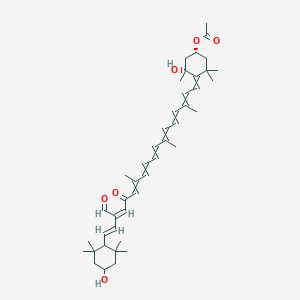



1. Cacp 29
2. Ifx-1
3. Vilobelimab
1. Ifx-1
2. J3.560.481b
| Molecular Weight | 672.9 g/mol |
|---|---|
| Molecular Formula | C43H60O6 |
| XLogP3 | 9.3 |
| Hydrogen Bond Donor Count | 2 |
| Hydrogen Bond Acceptor Count | 6 |
| Rotatable Bond Count | 13 |
| Exact Mass | 672.43898963 g/mol |
| Monoisotopic Mass | 672.43898963 g/mol |
| Topological Polar Surface Area | 101 Ų |
| Heavy Atom Count | 49 |
| Formal Charge | 0 |
| Complexity | 1480 |
| Isotope Atom Count | 0 |
| Defined Atom Stereocenter Count | 2 |
| Undefined Atom Stereocenter Count | 0 |
| Defined Bond Stereocenter Count | 2 |
| Undefined Bond Stereocenter Count | 7 |
| Covalently Bonded Unit Count | 1 |
Complement Inactivating Agents
Compounds that negatively regulate the cascade process of COMPLEMENT ACTIVATION. Uncontrolled complement activation and resulting cell lysis is potentially dangerous for the host. (See all compounds classified as Complement Inactivating Agents.)